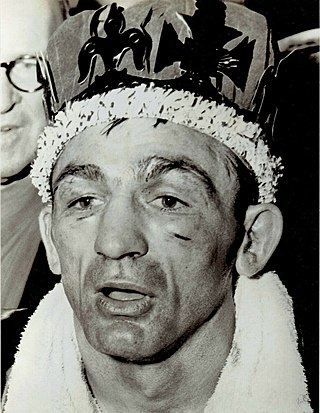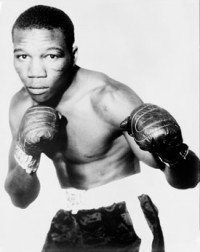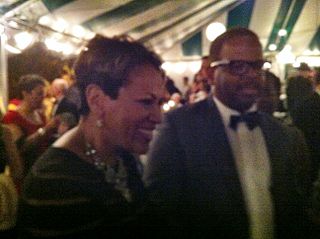
Walker Smith Jr., better known as Sugar Ray Robinson, was an American professional boxer who competed from 1940 to 1965. He was inducted into the International Boxing Hall of Fame in 1990. He is often regarded as the greatest boxer of all time, pound-for-pound.

Emile Alphonse Griffith was a professional boxer from the U.S. Virgin Islands who won world titles in three weight divisions. He held the world light middleweight, undisputed welterweight, and middleweight titles. His best-known contest was a 1962 title match with Benny Paret. Griffith won the bout by knockout; Paret never recovered consciousness and died in the hospital 10 days later.

Carmen Basilio was an American professional boxer who was the world champion in both the welterweight and middleweight divisions, beating Sugar Ray Robinson for the latter title. An iron-chinned pressure fighter, Basilio was a combination puncher who had great stamina and eventually wore many of his opponents down with vicious attacks to the head and body.
Ricardo Antonio Mayorga Perez is a Nicaraguan professional boxer and former mixed martial artist. In boxing he is a former two-weight world champion, having held the unified WBA (Unified), WBC, Ring magazine, and lineal welterweight titles in 2003, and the WBC super welterweight title from 2005 to 2006. Mayorga first became well known to boxing fans upon being featured on the cover of The Ring's December 2003 issue, entitled "The craziest man in the sport: Mayorga lights up boxing." He has since maintained this infamous reputation with his relentless trash-talk in the build-up to most of his fights, as well as his smoking and drinking habits outside the ring.

Kim Duk-koo was a South Korean boxer who died after fighting in a world championship boxing match against Ray Mancini. His death sparked reforms aimed at better protecting the health of boxers, including reducing the number of rounds in championship bouts from 15 to 12.

BernardoParet, known as Benny Paret or Benny "Kid" Paret, was a Cuban welterweight boxer who won the World Welterweight Championship twice in the early 1960s.

Dick Tiger was a Nigerian professional boxer who held the undisputed middleweight and light-heavyweight championships.

Giovanni "Nino" Benvenuti is an Italian former professional boxer and actor. He held world titles in two weight classes, having held the undisputed super-welterweight championship from June 1965 to June 1966 and the undisputed middleweight championship twice, from April to September 1967, and from March 1968 to November 1970. As an amateur welterweight boxer he won the Italian title in 1956–60, the European title in 1957 and 1959, and an Olympic gold medal in 1960, receiving the Val Barker trophy for boxing style. In 1961, having an amateur record of 120-0, he turned professional and won world titles in the light-middleweight division and twice in the middleweight division. Near the end of his boxing career he appeared in two Italian films, Sundance and the Kid (1969) and then in Mark Shoots First (1975).
During the 1960s, boxing, like mostly everything else around the world, went through changing times. Notable was the emergence of a young boxer named Cassius Clay, who would, in his own words shock the world, declare himself against war, and change his name to Muhammad Ali.
"Steel" is an episode of the American television anthology series The Twilight Zone. Set in the near future, its premise is that human professional boxing has been banned and replaced by android boxing. The story follows a once-famous human boxer who works as a manager for an antiquated android while struggling to come to grips with his career having been taken over by machines.

Joe Walcott, also known as Barbados Joe Walcott to distinguish him from the more recent American boxer known by the same name, was a Bajan professional boxer who reigned as the World Welterweight Champion from 1901 to 1906, becoming the first black man ever to capture the title. He was elected to The Ring Boxing Hall of Fame in 1955 and the International Boxing Hall of Fame in 1991.

Benny Leonard was an American professional boxer who held the world lightweight championship for eight years, from 1917 to 1925. Widely considered one of the all-time greats, he was ranked 8th on The Ring magazine's list of the "80 Best Fighters of the Last 80 Years" and placed 7th in ESPN's "50 Greatest Boxers of All-Time". In 2005, the International Boxing Research Organization ranked Leonard as the #1 lightweight, and #8 best pound-for-pound fighter of all time. Statistical website BoxRec rates Leonard as the 2nd best lightweight ever, while The Ring magazine founder Nat Fleischer placed him at #2. Boxing historian Bert Sugar placed him 6th in his Top 100 Fighters catalogue.

Lawrence Gene Fullmer was an American professional boxer and World Middleweight champion. He was known as TheUtah Cyclone, The Mormon Mauler, and as "Cyclone" Gene Fullmer.

Reuven "Ruby" Goldstein, the "Jewel of the Ghetto", was an American boxer and prize fight referee. He was a serious World Lightweight Championship contender in the 1920s, and became one of U.S. most trusted and respected boxing referees in the 1950s. During his boxing career, he was trained and managed by Hymie Cantor.

Luis Manuel Rodríguez was a Cuban professional boxer. Known as "El Feo", he began his career in pre-Castro Havana. In Cuba, he twice defeated the ill-fated future welterweight champion Benny Paret. He held the WBA, WBC, and lineal welterweight titles in 1963, and challenged once for the WBA, and WBC middleweight titles in 1969.

Juan Manuel Márquez Méndez is a Mexican former professional boxer who competed from 1993 to 2014. He is the third Mexican boxer to become a world champion in four weight classes, having held five world major titles from featherweight to light welterweight, including the lineal championship at lightweight.
Fight of the Week is a live American professional boxing series that aired on ABC-TV from 1960 to 1964.

Harry Lewis, was an American boxer, generally credited with holding the Welterweight Championship of the World from April 1908 to March 1911. He defeated "Young Joseph", the reigning Welterweight Champion of England in London on June 27, 1910, but was not credited with the British Welterweight championship as the fight was sanctioned as a World, and not English title. Boxing writer Nat Fleischer rated Lewis the sixth-greatest welterweight of all time. He was inducted into the International Jewish Sports Hall of Fame in 2002, and into the International Boxing Hall of Fame in 2008.
Danny Óscar Garcia is an American professional boxer. He has held multiple world championships in two weight classes, including the unified WBA (Super), WBC, Ring magazine and lineal light welterweight titles between 2012 and 2015, and the WBC welterweight title from 2016 to 2017. As of August 2020, he is ranked as the world's sixth best active welterweight by The Ring, seventh by the Transnational Boxing Rankings Board, and eighth by BoxRec.

Champion is an opera in two acts and ten scenes with music by Terence Blanchard and a libretto by Michael Cristofer. Based on the life of African-American welterweight boxer Emile Griffith, this opera is a joint co-commission by Opera Theatre of Saint Louis (OTSL) and Jazz St. Louis.














